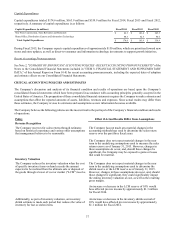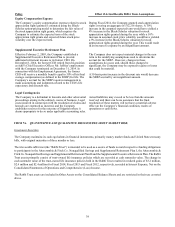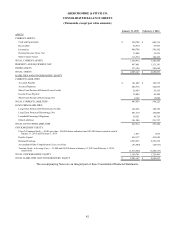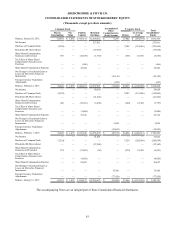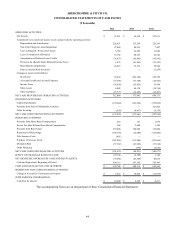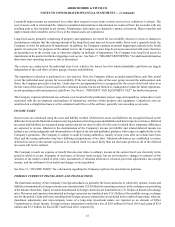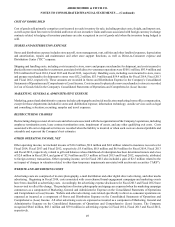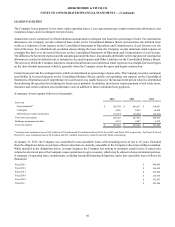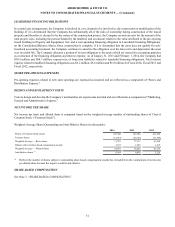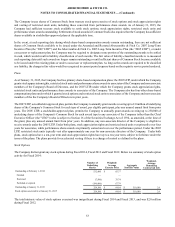Abercrombie & Fitch 2014 Annual Report Download - page 45
Download and view the complete annual report
Please find page 45 of the 2014 Abercrombie & Fitch annual report below. You can navigate through the pages in the report by either clicking on the pages listed below, or by using the keyword search tool below to find specific information within the annual report.45
ABERCROMBIE & FITCH CO.
NOTES TO CONSOLIDATED FINANCIAL STATEMENTS
1. NATURE OF BUSINESS
Abercrombie & Fitch Co. (“A&F”), a company incorporated in Delaware in 1996, through its subsidiaries (collectively, A&F and
its subsidiaries are referred to as “Abercrombie & Fitch” or the “Company”), is a specialty retailer that operates stores and direct-
to-consumer operations. Through these channels, the Company sells a broad array of products, including: casual sportswear apparel,
including knit and woven shirts, graphic t-shirts, fleece, jeans and woven pants, shorts, sweaters and outerwear; personal care
products; and accessories for men, women and kids under the Abercrombie & Fitch, abercrombie kids, and Hollister brands. The
Company also sells bras, underwear, personal care products, sleepwear and at-home products for girls through Hollister under the
Gilly Hicks brand. The Company operates stores in North America, Europe, Asia, Australia and the Middle East and direct-to-
consumer operations in North America, Europe and Asia that service its brands throughout the world.
2. SUMMARY OF SIGNIFICANT ACCOUNTING POLICIES
PRINCIPLES OF CONSOLIDATION
The consolidated financial statements include the accounts of A&F and its subsidiaries. All intercompany balances and transactions
have been eliminated in consolidation.
FISCAL YEAR
The Company’s fiscal year ends on the Saturday closest to January 31. All references herein to “Fiscal 2014” represent the 52-
week fiscal year ended January 31, 2015; to “Fiscal 2013” represent the 52-week fiscal year ended February 1, 2014; and to “Fiscal
2012” represent the 53-week fiscal year ended February 2, 2013. In addition, all references herein to “Fiscal 2015” represent the
52-week fiscal year that will end on January 30, 2016.
REVISIONS AND RECLASSIFICATIONS
The fifty-two week periods ended January 31, 2015 and February 1, 2014 included the correction of certain immaterial errors
relating to prior periods. The out-of-period correction of errors resulted in a reduction to income before taxes of $2.9 million, or
$1.8 million after tax, and an unrelated tax charge of $0.4 million, for a combined reduction to net income of $2.2 million for the
fifty-two week period ended January 31, 2015. The out-of-period correction of errors resulted in an increase to income before
taxes of $2.6 million, or $0.8 million after tax, and an unrelated tax charge of $0.9 million, for a combined reduction to net income
of $0.1 million for the fifty-two week period ended February 1, 2014. In addition, amounts recorded out-of-period included a
reduction to net cash provided by operating activities of $11.8 million for the fifty-two week period ended January 31, 2015. The
Company does not believe these corrections were material to any current or prior interim or annual periods that were affected.
USE OF ESTIMATES
The preparation of financial statements, in conformity with accounting principles generally accepted in the United States, requires
management to make estimates and assumptions that affect the reported amounts of assets and liabilities and disclosure of contingent
assets and liabilities at the date of the financial statements and the reported amounts of net sales and expenses during the reporting
period. Due to the inherent uncertainty involved with estimates, actual results may differ.
CASH AND EQUIVALENTS
Cash and equivalents include amounts on deposit with financial institutions, United States treasury bills, and other investments,
primarily held in money market accounts, with original maturities of less than three months.




